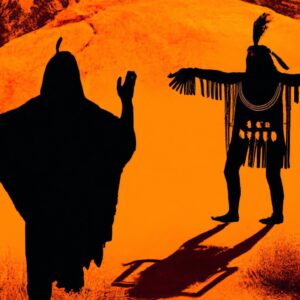Apache Clothing and Adornment Practical and Symbolic Significance
Introduction
In the vast, rugged landscapes of the American Southwest, the Apache people have thrived for centuries, their wisdom intertwined with the land and skies. Among the many threads of their rich cultural tapestry, their clothing and adornment stand out, reflecting both adaptation to their environment and a deep symbolic resonance. An Apache elder once said,
Every thread we wear carries the stories of our ancestors, each bead a prayer for strength and harmony.
This profound belief underscores how the Apache view clothing not merely as a shield against the elements but as a living canvas of identity and spirituality. Each garment and adornment crafted by Apache hands speaks volumes about the values and traditions of their communities. Their attire reflects a heritage where practicality seamlessly blends with an intricate symbolism that speaks to the heart of Apache wisdom.
At the heart of Apache clothing is the intricate weave of practicality and symbolic depth. Historically, the materials used in their garments provided protection and comfort amidst the diverse climates they inhabited. Animal hides and plant fibers were skillfully transformed into durable attire for everyday wear. Yet, beyond mere utility, these materials became powerful symbols, with specific items carrying spiritual meanings that resonated deeply within their culture.
The Apache also adorned themselves with striking jewelry made from turquoise, shells, and other natural elements, each piece signifying more than mere decoration. These adornments often serve as a bridge between the individual and the spiritual world, encapsulating prayers, blessings, and even tribal lore. Colors and designs incorporated into these pieces tell stories of lineage, tribal affiliation, and personal achievements, embodying the mystical elements of Apache life.
Historical Context
The Apache people, originally hailing from the Southwestern United States, adapted to their environment with ingenuity and resilience, which is vividly reflected in their clothing and adornment. The harsh landscape prompted the Apache to create attire that offered protection from the elements while allowing freedom of movement. They traditionally utilized materials readily available in their surroundings, such as animal hides, plant fibers, and later, woven fabrics from trade. E materials served dual purposes, blending practicality with cultural expression.
For the Apache, clothing and adornment were not merely functional; they were also imbued with symbolic significance, reflecting deep connections to their identity and spirituality. Embellishments such as beads and feathers were more than decorative, often carrying specific meanings or stories significant to the wearer. Women’s garments, for instance, were adorned with vivid designs that symbolized community ties and personal achievements. Men attire, practical and straightforward, also incorporated elements that signified status and prowess in hunting or battle.
Throughout history, Apache clothing evolved alongside external influences, including contact with European settlers and other Native American tribes. This interaction introduced new materials and motifs, leading to a fusion of traditional and acquired styles. Yet, amidst these changes, the Apache maintained a strong sense of identity, continuing to integrate ancestral wisdom into their dress and adornment. Our clothes speak of who we are and where we come from, echoes a sentiment expressed through generations.
The Apaches resourcefulness and cultural pride are mirrored in their attire, a testament to their enduring legacy. What one wore could communicate stories, beliefs, and even resistance, especially during periods of conflict and forced assimilation. As history unfolded, these garments became a symbol of resilience, a way for the Apache to retain their cultural heritage amidst external pressures. This intricate relationship between attire and identity highlights the profound wisdom embedded in Apache traditions, where every piece of clothing is a thread connecting past, present, and future.
Apache Clothing Symbolism Practicality
An Apache Story
Long ago, in the heart of the rugged Southwest, an Apache family prepared for a journey that extended beyond the physical world into the realms of ancestral wisdom and survival. As the family gathered around the evening fire, the elders shared stories laden with deep cultural meaning. The warm glow from the flames danced upon the blankets and garments adorned with beads and symbols, each weave echoing the voices of past generations.
The families garments, functional and intricate, told stories of their own. Every stitch had purpose; the carefully selected materials offered protection against natures elements. Buckskin, treated and softened, became a second skin, flexible yet strong. The adornments, colorful beads and intricate patterns, celebrated the seasons and marked rites of passage. To the Apaches, clothing became a living canvas, capturing the essence of their experiences.
Our garments whisper the language of our ancestors, the grandfather shared, his eyes reflecting wisdom gathered from countless summers and winters. They are more than coverings; they are storytellers and guardians, keeping us connected to our roots.
In preparing for the journey, young and old contributed to the garments’ creation, strengthening the bonds within the family. The children watched and learned, understanding that this was more than craftsmanship; it was a ritual of identity and survival. Each garment they created became interwoven with love, history, and pride. As they donned their handmade clothing, the family embraced the knowledge that they carried their heritage with them, no matter where they traveled.
Introduction
In the heart of the vast deserts and towering mountains, the Apache people thrived on their rich traditions, with each warrior adorned in garments that told stories of courage, identity, and unity. As threats loomed over their horizon, the brave warrior Antennae stood ready to defend his people. Through three distinct chapters, his journey unfolds, revealing the depth and significance of Apache clothing and adornments.
The Weaving of Strength
Antennae sat beside the gently crackling fire, the desert night wrapping its cool embrace around him. He watched Schools, the skilled weaver, as her nimble fingers danced over the loom. Each thread she wove bore a color of significance–deep reds like the earth, bright yellows like the sun, and serene blues weaving the sky into the fabric.
Schools, Antennae spoke, his voice a soft rumble, these designs, they speak of our ancestors. What do they whisper to you?
Strength, courage, unity, Schools replied, her eyes reflecting the flickering flames. Wear this, Antennae, and the spirits of old will ride with you into battle.
As Schools wrapped the woven garment around him, Antennae felt the weight of his lineage upon his shoulders–the courage of his forebears, their resolve stitched into the seams.
The Armor of Wisdom
The dawn broke over the horizon, casting amber hues across the land. Kursk, the elder and wise keeper of stories, approached Antennae with a leather pouch adorned with symbols of protection.
This is for you, Kursk said, handing over a beaded necklace. Each bead carries a lesson from my life, as it did from my fathers.
Antennae, holding the necklace, traced his fingers over the beads, feeling the smoothness against his calloused skin. What do these teach, wise one? He asked, his curiosity piqued.
Kursk laughed softly, the sound like a rustling breeze. Cunning like the coyote, patience like the great oak, and strength like the mountain. Wear it close, for wisdom guides the swift and shelters the brave.
As Antennae donned the necklace, he felt a newfound clarity, a keen awareness sharpened by the stories held within the beads.
The Battle of Symbols
As darkness fell, a palpable tension filled the air. Antennae stood at the edge of the village, his silhouette a testament to the fusion of strength and wisdom woven into his attire. The enemy approached, their figures mere shadows against the star-lit sky.
Our symbols make us invincible, Antennae, Schools voice called out, steady and unwavering despite the impending fight.
Antennae nodded, feeling the fabric tight against his chest and the weight of the beaded necklace. Each step forward resonated with purpose, the cloth and beads a shield imbued with the essence of his people.
In the clash of night, where echoes of battle cries mingled with the howl of the wind, Antennae fought–not just with his spear but with the legacy of his tribe. Tales woven into his cloak sang out in defiance, the wisdom of the necklace guiding each strike.
As the dust settled and victory hung heavy in the air, Antennae returned to his tribe, honored and unharmed. The garments of strength and wisdom had not only protected him but had united the spirits of past and present.
The tale of Antennae teaches us that our heritage is more than words; it is woven into our being. How can you wear your own history, embodying the lessons of those who came before you?
Practical Applications
Sure, I’ll guide you through implementing the principles of Apache clothing and adornment in daily life, emphasizing both practicality and symbolic significance. Here show you can do it:### Steps to Implement Apache Clothing and Adornment Principles
- Research Apache Traditions: Begin by understanding the symbolic significance of Apache clothing. For the Apache people, garments were often intricately crafted with beads, feathers, or shells to convey status, tribe identity, or spiritual beliefs. Start by reading about these traditions or attending cultural events to comprehend these deep-rooted meanings.
- Incorporate Natural Materials: Apache clothing traditionally used natural materials like leather, wool, and cotton. Incorporate these materials into your wardrobe to not only honor the natural world but also to appreciate the sustainable aspect. Look for clothes made from organic or recycled materials.
- Emphasize Functionality: Function was key in Apache attire, tailored to suit the environment and lifestyle. Apply this principle by ensuring your clothing is suitable for your activities and climate. Consider clothing items that offer protection against weather while being comfortable and practical.
- Add Symbolic Elements: Integrate symbolic elements that resonate with you. Maybe it’s a specific color or pattern that holds personal significance. For example, certain colors in Apache culture convey different meanings; turquoise is often seen as a symbol of life and prosperity.
- Support Indigenous Artists: Purchase items from Indigenous creators who incorporate traditional designs and techniques. By doing so, you’re not only respecting the authenticity of the craft but also supporting the community.
- Adopt Storytelling Through Attire: Let your clothing tell a story. Each Apache garment often tells a story or reflects personal history. Think about how your clothing choices can reflect your personal journey or values.
- Express Individuality with Respect: Use elements of Apache embellishments, like beaded accessories or motifs, respectfully to convey individuality while acknowledging the cultural significance. Make sure the choice of symbols is informed and respectful.
### Potential Challenges and How to Overcome Them
One potential challenge is accessing authentic resources or Apache-designed materials. To address this, connect with cultural communities online or locally, attend workshops, or visit Indigenous markets where traditional crafts are sold. Another challenge might be understanding the cultural context without appropriation. Overcome this by educating yourself thoroughly and engaging in conversations with members of the Apache community.
### Tips for Maintaining Consistency
To maintain consistency, set reminders to revisit your understanding of Apache culture regularly. Incorporate these elements gradually, possibly starting with accessories and expanding from there. Engage with community events or online forums to stay informed about evolving traditions and perspectives. How might you adapt these principles to not only honor Apache culture but also to reflect and respect your personal ethos?
Potential Challenges
Content for this section.
Tips for Maintaining Consistency
Content for this section.
Apache Clothing Symbolism Practicality
Conclusion
Apache clothing and adornment carry profound practical and symbolic significance. Rooted in a deep understanding of the environment, these garments serve both functional and cultural purposes. The intricate designs and materials used not only provide protection and comfort but also convey identity, status, and spiritual beliefs. Patterns speak of ancestral stories, while adornments often symbolize a connection to nature and community.
The wisdom embodied in Apache attire reflects a harmonious relationship between people and the land. This connection fosters resilience and adaptability, traits essential for survival. By wearing their heritage, the Apache people keep their customs alive, passing down values and lessons from one generation to the next. This continuity underscores the importance of preserving cultural heritage amidst modern challenges.
To appreciate Apache clothing is to recognize its role as a living tradition that speaks to past, present, and future. It invites admiration for the craftsmanship and the deeper meanings woven into each piece. Let us honor and respect these traditions by supporting efforts to document, understand, and share Apache cultural practices. Engaging with these living traditions enriches our appreciation of diversity and deepens our connection to humanities shared history.
More Resources
Dive deeper into the fascinating world of Apache wisdom and its modern applications. Explore these thought-provoking questions to expand your understanding of the concepts discussed in this article.
Explore Further with Google
- How can we integrate cultural heritage in our health and wellness?
- How can we share ancestral traditions in our education systems?
- How can we understand indigenous wisdom in our personal growth?
Discover Insights with Perplexity
- How can we pass down traditional practices in our climate change?
- What lessons from the past can guide our sustainable future?
- How can we learn from indigenous knowledge in today’s world?
By exploring these questions, you’ll gain a richer appreciation for indigenous cultures, environmental stewardship, and mindfulness practices. Each link opens a gateway to deeper knowledge, helping you connect ancient wisdom with contemporary life.
Thank you for reading!







